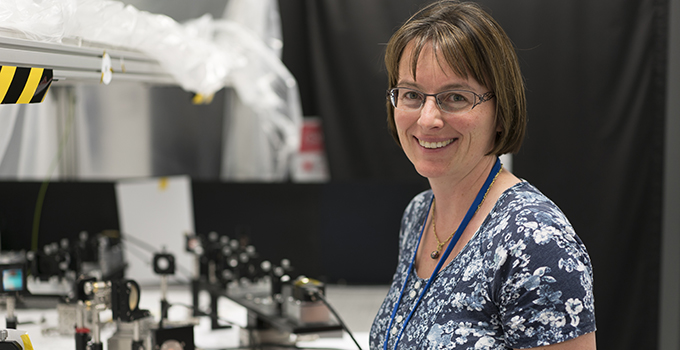Star light, star bright

“I create artificial stars with lasers.”
As far as job descriptions go, Associate Professor Céline d’Orgeville has a pretty good one.
And that’s just the beginning.
Her artificial stars are part of a project to shoot lasers at space junk orbiting the Earth before they cause a catastrophic collision.
It sounds like it could be straight out of the movie Gravity.
Well, almost.
“We don’t actually use the word ‘shoot,’” says Associate Professor d’Orgeville, an instrumentation scientist at the ANU Research School of Astronomy and Astrophysics.
“But yes, that is essentially what we are doing.
“We use laser pulses to measure where the satellite or the debris is in space, and predict where they’re going to be in the near future.
“If there is a collision predicted, we can manoeuvre the debris by using a powerful laser to nudge it out of the way of the satellite.”
As anyone who’s seen Gravity knows, the risk posed by the 300,000 pieces of space junk currently orbiting Earth is a serious one for spacecraft, and also for the satellite technology we use in everything from an ATM to a GPS.
“There’s a very high risk there’s going to be more and more cascading collisions, to the point where it won’t be safe to send man missions—or even anything—into space.”
Associate Professor d’Orgeville’s role is in adaptive optics, creating laser guide stars as a reference source to measure and correct for atmospheric turbulence.
She is also the lead scientist on the Laser Guide Star Facility for the Giant Magellan Telescope, the most powerful telescope in the world, currently under construction in Chile, and in which ANU is a founding partner.
And she is looking for students in the Master of Astronomy and Astrophysics to help her.
“These projects are growing right now, and we’re going to need more and more people working on them.
“So we’re looking for students who want to get involved, and also future colleagues.
“It’s really a once-in-a-lifetime opportunity for students.”
The ANU Research School of Astronomy and Astrophysics operates Australia’s largest optical observatory, has access to the world’s largest optical telescopes, and is leading Australian participation in the next-generation Giant Magellan Telescope.
Our staff and students have made major contributions to astronomy, mapping the structure and formation of the Milky Way, discovering planets orbiting other stars, measuring the dark matter both within our Galaxy and in the wider Universe, and discovering the accelerating expansion of the Universe. Our staff include winners of the Prime Minister’s Prize for Science and the Nobel Prize.
The Advanced Instrumentation and Technology Centre at the School designs, builds and tests world-leading instrumentation for astronomy and space science.
